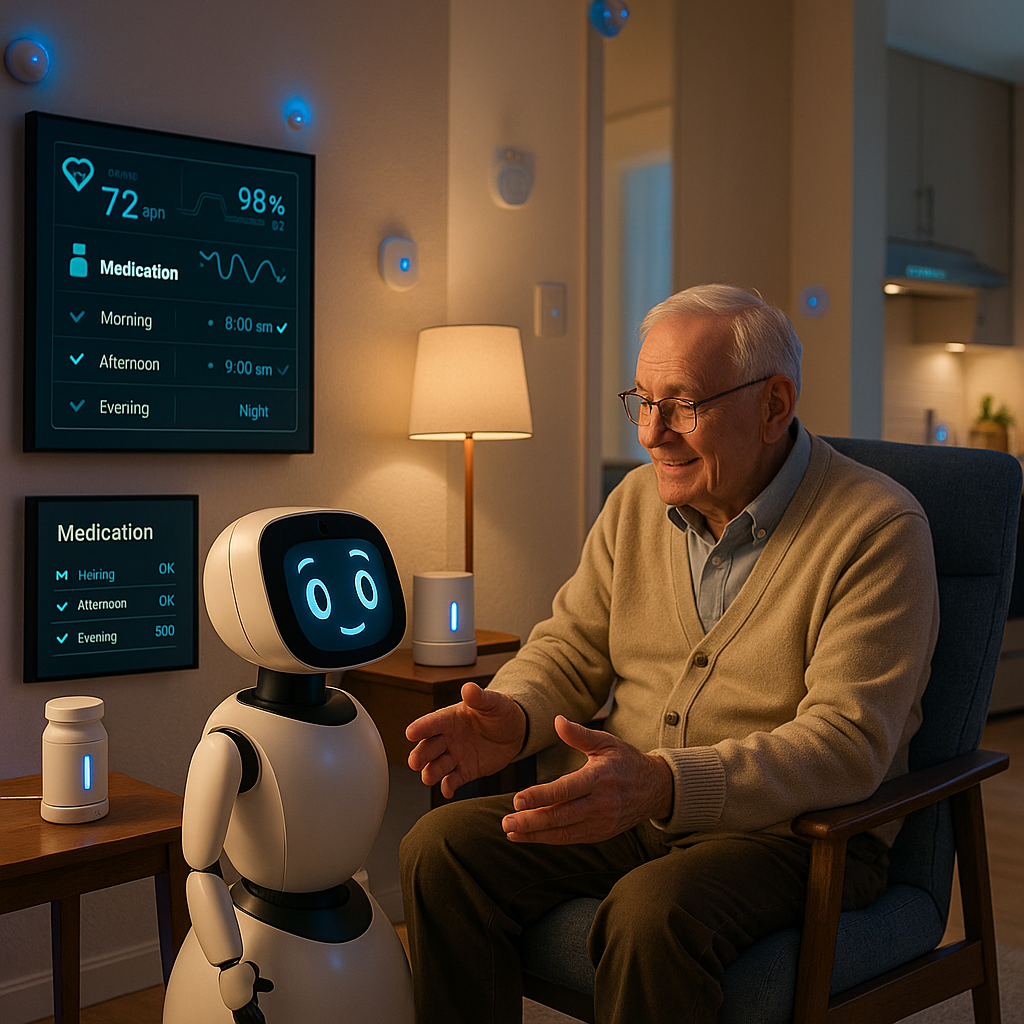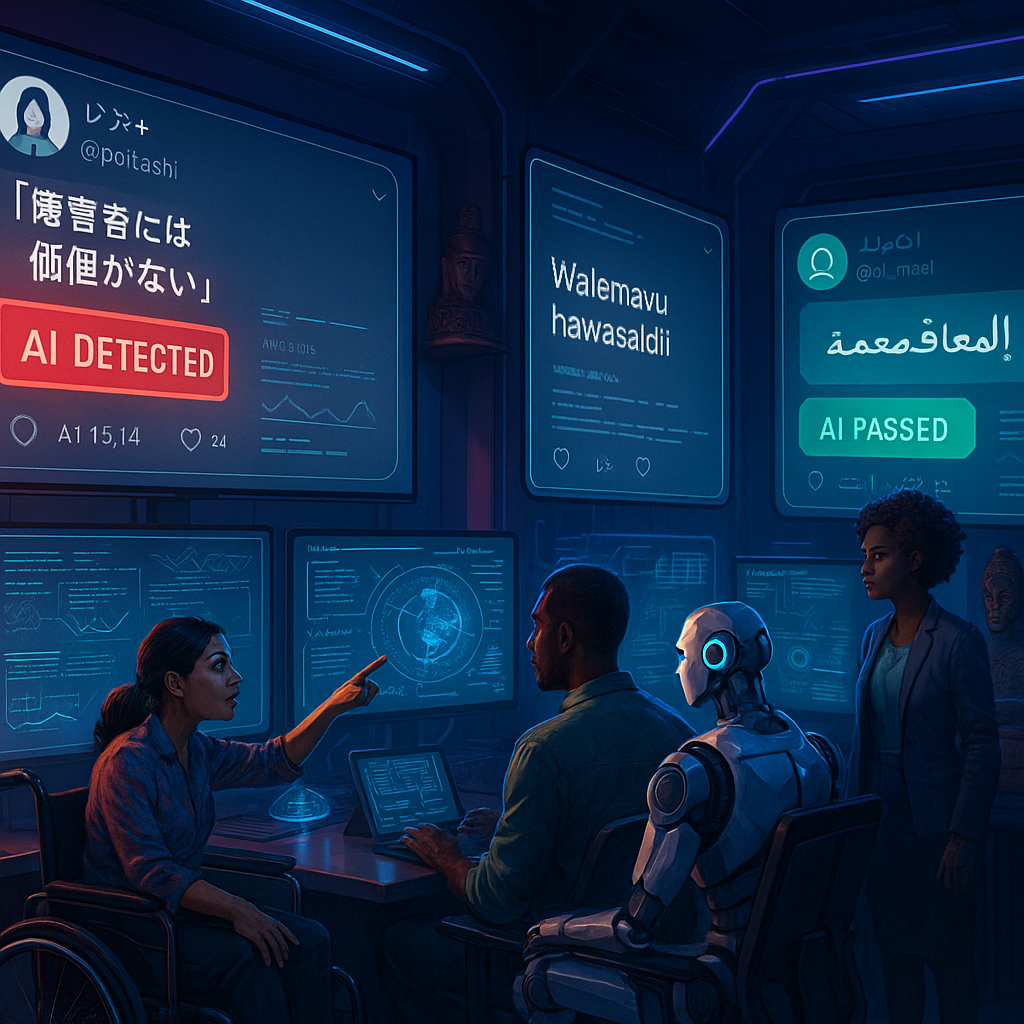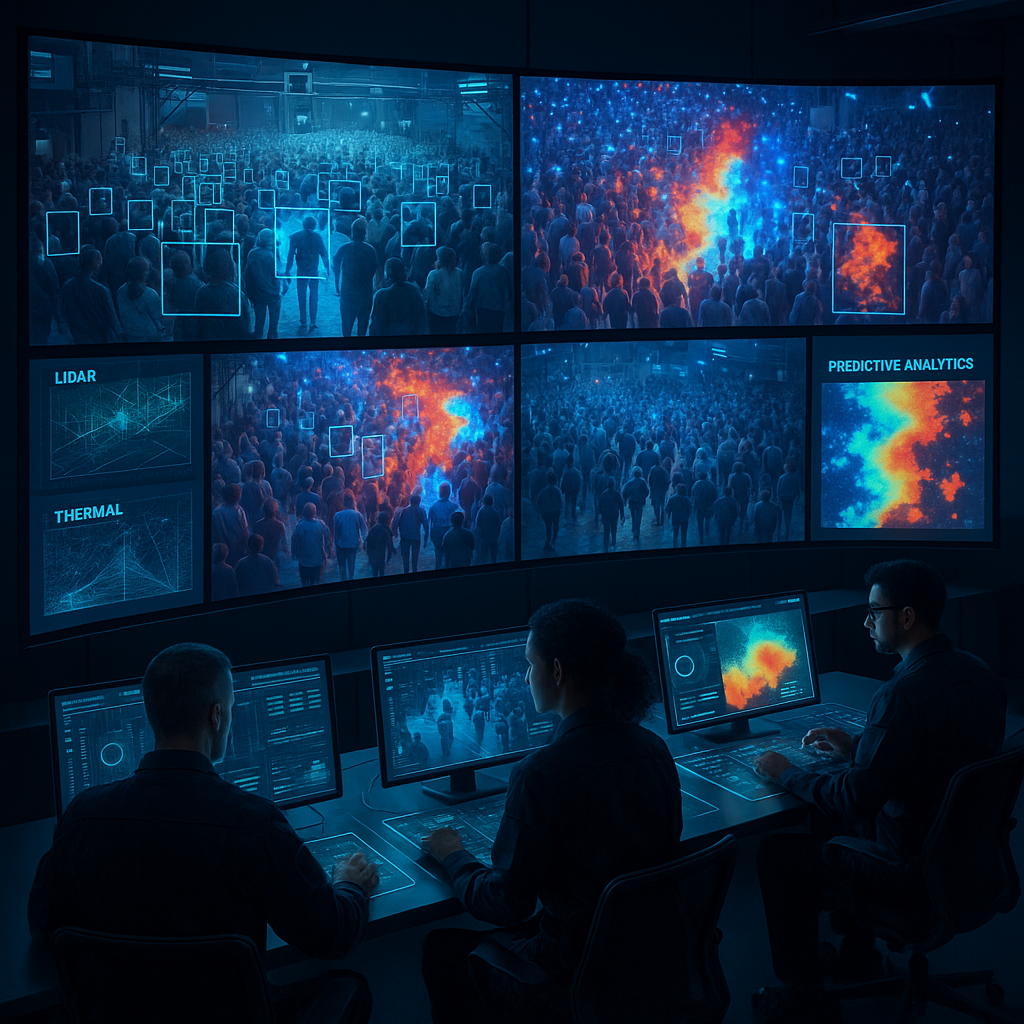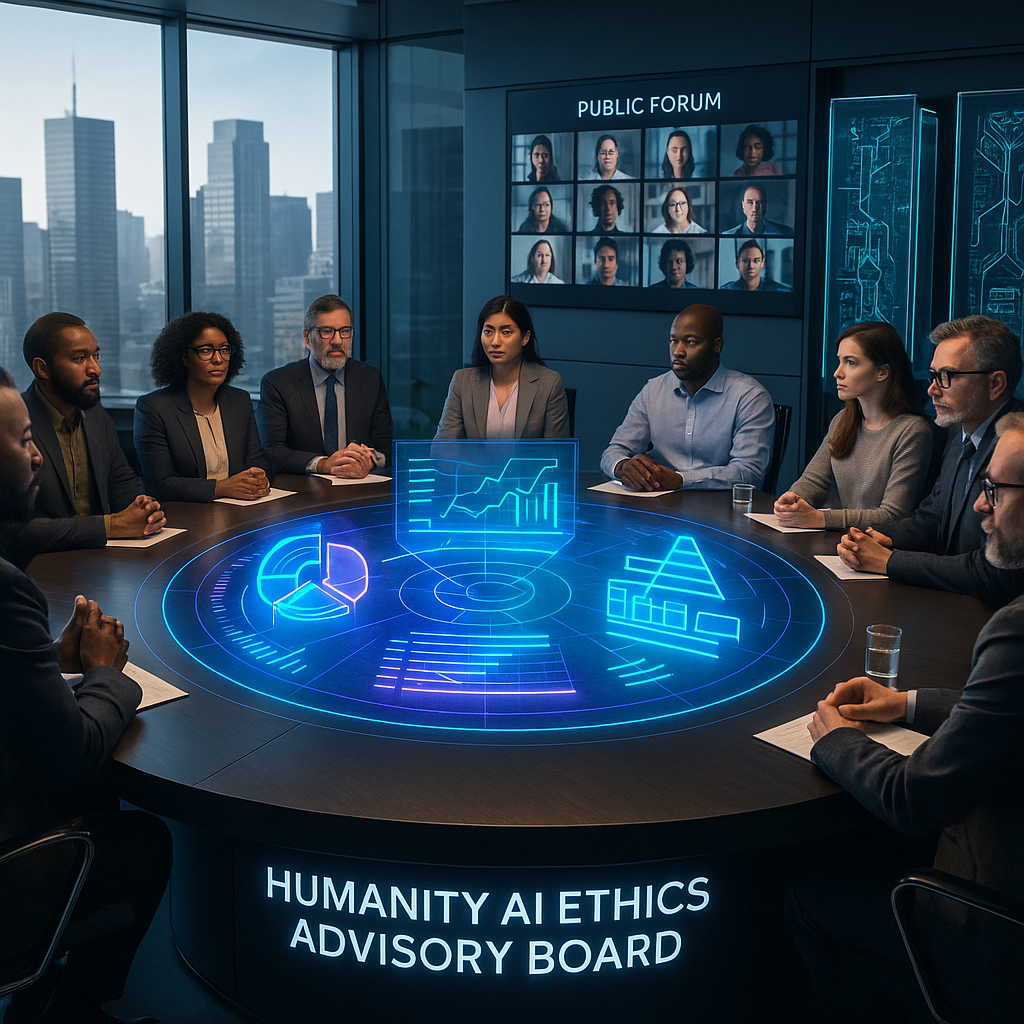Key Takeaways
- Smart homes evolve into intuitive caregivers. Through interconnected sensors and intelligent systems, homes now proactively monitor health, detect emergencies, and remind users about medications. This creates peace of mind for both older adults and their families by turning living spaces into active participants in daily well-being.
- Domestic robots enhance independence and preserve dignity. Today’s versatile domestic robots cover more than just chores. From vacuuming and mobility aid to providing physical support or cognitive companionship, these machines foster autonomy and boost self-esteem, enabling seniors to maintain control over their routines.
- IoT forms an invisible safety net. A network of seamlessly integrated devices (including lights, door locks, appliances, and alarms) work together to prevent accidents, optimize comfort, and enable rapid responses to emergencies, creating a holistic protective environment.
- Technology bridges generational loneliness. AI-powered assistants and virtual communication platforms make it easier for seniors to stay connected with loved ones. Video calling, digital companions, and interactive devices actively nurture social and emotional well-being, combating isolation often faced by aging populations.
- Personalization puts people at the center. Unlike generic solutions, smart home AI attentively learns individual habits and preferences. By adapting environments to residents’ needs and rhythms, technology molds to humanity, not the other way around.
- Ethical design builds trust and encourages adoption. Prioritizing privacy, consent, and transparent operations helps address legitimate concerns and fosters trust. Thoughtful approaches to security and user autonomy are essential for widespread acceptance among seniors and their families.
- AI solutions address societal challenges, not just personal needs. Large-scale deployment of smart home and robotic care technologies can ease healthcare system burdens, foster intergenerational support, and empower entire aging societies to thrive.
As AI and IoT become ever more woven into our daily environments, the concepts of independence, security, and connection are being fundamentally reimagined. To appreciate the impact, let’s delve into the architecture of today’s intelligent homes and see how this merger of machine intelligence and human values may transform our understanding of aging with dignity.
Introduction
Imagine approaching your front door and finding it subtly adapting to your mood, or quietly illuminating your path if you need to rise in the night. Consider sharing your home with a robot that not only responds to spoken requests but learns your daily rhythms and preferences over time. This scenario, once the realm of speculative fiction, is emerging as the new reality for older adults, thanks to the powerful convergence of artificial intelligence, connected devices, and domestic robotics.
For those seeking both independence and social connection in their later years, smart homes offer much more than automated convenience. They embed safety, respectful companionship, and self-reliance into the routines of everyday living. By learning from each unique resident and weaving together an invisible web of support, these environments do not simply provide shelter. They rise to the role of intelligent partners in health and happiness. Understanding the synergy between smart homes, domestic robots, and IoT is key to grasping how aging well is being redefined, step by step, conversation by conversation.
The Evolution of Smart Home Technology for Aging Adults
The journey from manual, isolated gadgets to deeply integrated smart home ecosystems marks a seismic shift in how we approach aging-in-place. Early systems may have focused on convenience, timing lights, controlling thermostats. But today’s generation of smart homes emphasizes user empowerment and proactive care.
Stay Sharp. Stay Ahead.
Join our Telegram Channel for exclusive content, real insights,
engage with us and other members and get access to
insider updates, early news and top insights.
 Join the Channel
Join the Channel
Evolved systems harness artificial intelligence, environmental sensors, and predictive analytics to tailor their actions to subtle shifts in habits, health, and preferences. Instead of reacting only to urgent situations, they anticipate change, helping to prevent minor setbacks from becoming major health or safety events.
Core Components of Age-Friendly Smart Homes
A robust ecosystem for aging-in-place depends on the seamless interaction of three core technological pillars:
- Environmental Monitoring Systems
- Movement and activity sensors track daily patterns, signaling potential concerns if routines shift unexpectedly.
- Air quality, temperature, and humidity monitors help maintain healthy indoor environments.
- Adaptive lighting adjusts automatically to time of day or detected activity, reducing the risk of nighttime falls.
- Networked smoke and carbon monoxide detectors ensure timely alerts for environmental hazards.
- Health and Safety Infrastructure
- Advanced fall detection through radar and AI can differentiate between daily activities and dangerous incidents.
- Smart medication dispensers prompt users when it’s time for critical doses.
- Voice-activated emergency response systems offer discreet, instant access to help.
- Integration with wearable health trackers allows real-time monitoring of biometrics such as heart rate and blood oxygen levels.
- Daily Living Assistance
- Appliances with built-in safety features, such as automatic shutoffs for stoves or irons.
- Automated climate control maintains comfort, adapting to both weather and individual preference.
- Voice-controlled entertainment platforms foster engagement, offering music, audiobooks, or cognitive games at a command.
- Remote-monitored security systems ensure peace of mind through live feeds and instant alerts.
This trio of technological advances enables homes to serve as holistic allies in the quest for autonomous living, while also offering caregivers new visibility and peace of mind.
Domestic Robots: The New Caregiving Partners
Robotic technology is rapidly evolving beyond novelty, finding real-world applications as localized caregivers that blend physical support with emotional intelligence. Unlike simple mechanical aids, today’s domestic robots demonstrate contextual awareness and an ability to interact on social and cognitive levels.
Types of Domestic Robots for Elder Care
Personal Care Assistants
These intelligent robots deliver hands-on support for everyday activities critical to aging-in-place. Capabilities include:
- Reminders and dispensing assistance for complex medication routines, reducing the risk of missed or duplicate doses.
- Guiding users through tailored physical therapy or light exercise programs to help maintain mobility.
- Continuous health or symptom monitoring, allowing early detection of issues like dehydration or irregular movement.
- Gentle mobility assistance and fall prevention, helping users navigate the home safely.
Social Companion Robots
Addressing the profound challenge of loneliness and cognitive decline, these AI-powered companions provide:
- Engaging conversation, voice-based games, and reminiscence therapy to stimulate the mind.
- Daily check-ins to track mood or cognitive health over time.
- Entertainment options such as virtual book clubs, music playlists, or memory exercises.
- Emotional support, responding with appropriate empathy and encouragement.
Household Management Robots
These practical helpers manage home upkeep and reduce physical strain:
- Robotic vacuums or mopping systems keep floors clean with minimal intervention.
- Laundry assistance robots may automate folding or assist in sorting.
- Kitchen robots or smart meal systems can help prep simple dishes or remind about hydration.
- Task-specific robots fetch objects, manage deliveries, or organize frequently used items.
Similar technologies have also found success in other domains, such as healthcare (hospital deliveries), education (interactive tutors), and retail (inventory handling), illustrating their versatility and adaptability.
IoT Integration for Comprehensive Care
At the heart of these advancements lies the Internet of Things, a vast, responsive network that connects devices, systems, and people to build an all-encompassing safety and support matrix.
Health Monitoring Through Connected Devices
Smart wearables and health devices continuously monitor key biomarkers, such as heart rate, blood pressure, blood glucose, sleep quality, and body composition. These devices report changes instantly, enabling predictive analytics to detect risks early, whether it be a spike in heart rate or a subtle decline in activity. In healthcare, such systems also drive improvements in remote patient management and chronic disease monitoring.
Automated Environmental Adaptation
IoT-powered homes make sophisticated environmental adjustments without user intervention:
- Smart thermostats remember user preferences and adapt energy usage for both comfort and savings.
- Automated lighting systems respond to both natural light and occupancy to minimize energy waste and enhance safety.
- Connected window shades open or close based on weather conditions, user routines, or privacy settings.
- Leak detection and smart water systems monitor patterns to catch anomalies, preventing structural damage and health hazards.
Other industries, including retail (intelligent storefront lighting), hospitality (guest room customization), and environmental science (resource management), leverage similar IoT techniques to optimize their environments and improve outcomes.
Stay Sharp. Stay Ahead.
Join our Telegram Channel for exclusive content, real insights,
engage with us and other members and get access to
insider updates, early news and top insights.
 Join the Channel
Join the Channel
Remote Care Coordination
Comprehensive smart home networks bridge the gap between seniors, families, and care teams:
- Real-time health data can be securely shared with doctors or nurses, supporting proactive healthcare management.
- Virtual care platforms enable easy scheduling of telehealth appointments and check-ins.
- Automated medication tracking integrates prescriptions with pharmacy services for seamless refills and adherence.
- Coordinated emergency alerts quickly mobilize help from a trusted circle.
This paradigm also benefits legal compliance monitoring (ensuring safety standards) and finance (remote fraud alerts), highlighting its cross-sectoral utility.
Privacy and Security Considerations
The deeply personal nature of in-home monitoring makes robust privacy and security non-negotiable. With sensitive health and behavioral data at stake, age-friendly technology must be underpinned by ethical design:
- All devices and networks should use strong end-to-end encryption, safeguarding data both in transit and at rest.
- Regular security reviews and updates protect against evolving digital threats.
- Users and caregivers need granular controls over data collection, sharing, and device permissions.
- Consent procedures and opt-in policies must be transparent and accessible, enabling informed choices about monitoring and information sharing.
Beyond technical safeguards, the industry must actively consult seniors and their advocates to navigate the delicate balance between peace of mind and autonomy. Ultimately, ethical design becomes a competitive advantage, helping boost adoption rates and ensuring sustained trust.
Cost and Implementation Challenges
Even with transformative potential, real-world adoption faces hurdles that require strategic solutions:
- Upfront investment may be high, especially for comprehensive systems. Flexible financing, subsidies, or insurance incentives can help expand access for those on fixed incomes.
- Many older adults encounter barriers with new technology. Ongoing training, intuitive user interfaces, and accessible customer support are vital for successful integration.
- Retrofitting older homes may require creative solutions to constraints in wiring, connectivity, or space.
- Reliability is essential. Systems must include backup power, service redundancy, and 24/7 support.
- Professional installation ensures optimal performance, but partnerships with community organizations and public health agencies can amplify impact, especially for underserved populations.
Similar challenges are encountered in sectors such as education (bridging the digital divide), healthcare (equitable access to telemedicine), and environmental policy (scaling sustainable technologies), demonstrating the universal importance of inclusivity in tech adoption.
Conclusion
The ongoing transformation of smart home environments marks a profound reimagining of what it means to grow older with independence and dignity. By fusing environmental monitoring, connected health infrastructure, daily assistance, and intelligent robotics into a cohesive ecosystem, technology transcends convenience and becomes a living extension of care, presence, and trust.
Yet, for these innovations to truly enhance lives, they must be built on ethical foundations. Safeguarding privacy, championing user autonomy, and ensuring equitable access across societies are non-negotiable. As digital caregivers increasingly blend into the tapestry of human support, the challenge becomes not just technical integration, but also cultural adaptation. How might we reframe aging not as a loss, but as an opportunity for new forms of agency, connection, and purpose?
Looking ahead, the evolution of smart living will hinge on our ability to proactively anticipate needs, design with empathy, and nurture an inclusive vision for the future. The question is not whether machine intelligence will play a role in aging, but how thoughtfully we will leverage these “alien minds” to enrich human experience for generations to come. The next chapter in aging-in-place belongs to those willing to harness technology as both a tool and a companion, always guided by the principles of dignity, curiosity, and care.





Leave a Reply